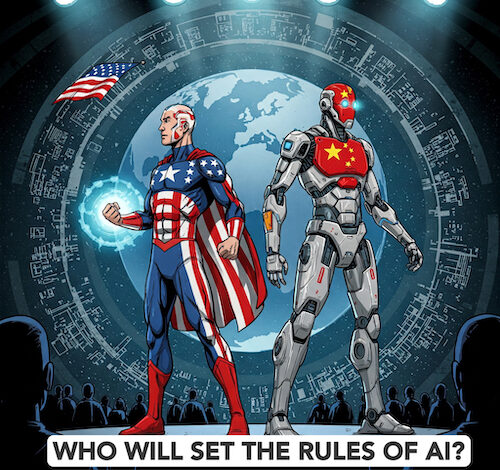
In the rapidly evolving landscape of artificial intelligence (AI), China’s leading AI players—including DeepSeek, Alibaba DAMO Academy, and Baidu’s ERNIE—are redefining the paradigm of AI power. They have moved beyond brute-force compute to a model of efficiency-driven AI innovation, challenging the long-held assumption that hardware dominance alone dictates AI supremacy.
This shift is not merely technological; it is geopolitical. The real AI Race is no longer about who has more chips—it is about who writes the rules.
Both Washington and Beijing risk falling behind not because they lack the best technology, but because they are not recognizing fast enough that AI competition is about governance, not just innovation. The nation that first establishes dominant AI standards—across security, deployment, and international adoption—will set the foundation for AI’s global future.
America’s AI strategy is stuck in the past
For decades, Washington has built its technological supremacy on a simple equation: more computing power equals more innovation. This logic fueled Silicon Valley’s dominance and cemented America’s edge in AI. The assumption was clear—whoever controls the most advanced chips, the most powerful data centers, and the largest AI models will dictate the future of artificial intelligence. And for a time, it worked.
But that equation is no longer holding. While the United States has poured billions into compute-heavy AI models, China has quietly rewritten the rules of competition. The rise of DeepSeek, often called “China’s OpenAI,” signals a turning point. Instead of chasing trillion-parameter models that demand vast amounts of computing power, DeepSeek and other Chinese firms are advancing efficiency-first AI—a fundamentally different approach that challenges Washington’s long-standing belief that hardware dominance is the key to AI supremacy.
At the heart of this shift is China’s adaptation to U.S. semiconductor restrictions. When the Biden administration expanded export controls on AI chips in 2023, the goal was to cripple China’s access to cutting-edge computing power and slow its AI progress. Yet, rather than stalling, Chinese firms have accelerated their technological self-sufficiency. The assumption that restricting access to Nvidia’s GPUs would halt China’s AI ambitions has proven not just flawed, but counterproductive.
DeepSeek’s breakthroughs highlight an emerging reality: AI success is no longer solely dependent on brute-force computing. Chinese firms are developing heterogeneous computing architectures, mixing older-generation chips with new accelerators to optimize efficiency. Biren, Alibaba, and Huawei Ascend are pushing forward with custom AI chips that deliver strong performance without relying on American semiconductor giants. And software innovations are enabling Chinese AI systems to do more with less, reducing their dependence on restricted high-end hardware.
The result is a strategic pivot that Washington has yet to fully recognize. While U.S. policymakers remain focused on restricting China’s access to compute power, the true competition is shifting elsewhere. China is not just finding workarounds to U.S. sanctions—it is pioneering an alternative AI development model. Washington is playing Five-in-a-Row while China is playing Go, relying on clumsy attempts to block and contain rather than mastering the broader strategic landscape.
Recent performance metrics reveal the consequences of this paradigm shift. While U.S. companies chase raw capability at any cost—OpenAI’s GPT-4 reportedly required over $100 million in compute resources alone—Chinese firms have engineered a fundamentally different approach. Baidu’s ERNIE 4.0, with significantly fewer parameters than GPT-4, now matches or exceeds its performance in complex reasoning tasks according to the company’s internal benchmarks. More telling is the efficiency revolution: DeepSeek-Coder achieves 94% of the functionality of GitHub Copilot while requiring 70% less computational resources to run and having been trained on fewer examples. By December 2024, four Chinese models had entered the global top 10 on the MMLU benchmark leaderboard—a proxy for general AI capability—while utilizing computing resources that would be considered inadequate by Silicon Valley standards.
The metrics tell a stark story: the U.S. leads in absolute performance, but China leads in performance-per-compute—and in a world of constrained chip access, that metric matters more. The average Chinese large language model now delivers 80% of U.S. model functionality at approximately 30% of the computational cost, according to Stanford HAI’s 2024 AI Index Report. This isn’t merely adaptation; it’s a fundamental reimagining of AI’s development trajectory that challenges the entire premise of Washington’s containment strategy.
And in doing so, China is challenging America’s ability to dictate the global AI landscape.
The battle for AI standards is the real war
In the AI competition between the U.S. and China, the race is no longer just about technological breakthroughs—it is about securing governance dominance in the areas that will define AI’s global trajectory. The contest is not about who builds the most powerful AI models, but about who ensures their models become the global standard. The nation that controls access, writes the rules, dominates the infrastructure, and integrates AI into the economy, infrascture, and other important national interest first will dictate the direction of the AI revolution for decades.
In the past, the most widely used technology dictated the rules: the country that set the standards for telecommunications, the internet, and cloud computing gained long-term economic and political influence. AI is following the same trajectory.
The internet protocol battle of the 1980s and 1990s offers the most illuminating parallel to today’s AI governance competition. When the U.S. Department of Defense developed TCP/IP and the U.S. dominated early internet infrastructure, it wasn’t just a technical victory—it was the silent embedding of Western governance values into the digital world’s architecture. The decentralized nature of TCP/IP reflected American ideals of openness, creating a network resistant to centralized control. Had the Soviet Union’s alternative X.25 protocol or later China’s proposed “New IP” become the standard, today’s internet would operate on fundamentally different principles—with built-in surveillance capabilities and government-controlled choke points. The U.S. didn’t just build better technology; it encoded its values into the infrastructure that now shapes billions of lives daily.
Domain Name System (DNS) governance further cemented this advantage. By maintaining control through ICANN, the U.S. ensured that internet addressing followed Western norms of private sector leadership with limited government intervention. This governance architecture now mediates virtually all global digital communication, influencing everything from free expression to digital commerce. When China attempted to propose alternative DNS roots in the 2000s that would enable greater censorship and state control, the established standards architecture proved remarkably resilient—not because the Chinese alternatives lacked technical merit, but because the governance frameworks were already locked in place.
The nation that defines how AI integrates with society, commerce, and governance will achieve a similar decades-long advantage. Just as internet protocols invisibly shape what’s possible online, AI governance frameworks will determine the boundaries of artificial intelligence’s role in human affairs. This isn’t merely about market dominance—it’s about whose vision of human-machine interaction becomes the default model for generations. The winner of this race will not be the country that merely builds the most powerful AI models but the one that successfully locks in control over the infrastructure, governance norms, and security architecture that shape AI’s global deployment.
One of the most immediate battlegrounds is AI model accessibility. Washington is moving aggressively to restrict access to its most advanced AI models, citing national security concerns. Export controls are no longer limited to chips; they now include foundation models themselves, limiting how widely they can be deployed beyond U.S. and allied markets. China, by contrast, is taking the opposite approach—pushing for open-source, efficiency-driven models that make AI accessible to a much broader audience. The strategic calculus here is clear: whoever builds the most widely used AI framework will have the greatest influence over AI’s future governance. The more countries and industries adopt a particular AI model, the more they will depend on the regulatory standards embedded within that ecosystem. If the U.S. over-restricts access to its AI, it risks pushing developers and companies in the Global South—and potentially even some Western markets—toward Chinese alternatives.
Beyond access, AI governance itself is at stake. The U.S. has positioned itself as the leader in “responsible AI”, emphasizing alignment, safety, and ethical guardrails. In principle, this approach ensures AI is developed and deployed in ways that mitigate risks. But in practice, stringent AI safety requirements—especially those tied to national security—could slow adoption and limit AI’s commercial scalability. China, in contrast, prioritizes state oversight and flexible AI deployment, allowing for rapid industrial and commercial integration. Beijing’s AI governance framework is pragmatic, focused on making AI usable and immediately deployable, particularly in industries like manufacturing, finance, and logistics. This approach appeals to governments and corporations that are less concerned with the ideological debates over AI alignment and more interested in practical applications. The fundamental divide is clear: the U.S. seeks to constrain AI development under a strict regulatory regime, while China is creating a governance system that allows for rapid AI expansion, particularly in emerging markets.
AI infrastructure—the backbone of AI deployment—may ultimately be the decisive factor. The U.S. dominates cloud AI computing, with AWS, Microsoft Azure, and Google Cloud controlling much of the infrastructure that trains and deploys AI models. This has given Washington a powerful tool for controlling AI access, since many of the most advanced models require cloud-based training that only a handful of Western firms can provide. But China is rapidly building alternative AI cloud platforms to reduce dependence on American technology. If Beijing succeeds in creating a parallel AI cloud ecosystem—one that is cheaper, faster, and more integrated into non-Western economies—it will gain leverage over global AI deployment. Whoever controls the “digital highways” of AI will dictate the speed, accessibility, and even the rules governing AI adoption worldwide.
Perhaps the most overlooked aspect of this competition is how AI shapes the future global economy. AI is not just another industry—it is becoming the underlying infrastructure for finance, healthcare, military operations, and economic planning. Whoever gets there first in defining how AI integrates into these sectors will dictate the economic order of the AI age. But security remains an unsolved issue. AI is not just an economic tool; it is also a high-value attack surface. Right now, most AI companies treat security as an afterthought—a patch rather than a core system function. AI, like financial systems, needs to be designed with security at its core, not as an add-on to fix vulnerabilities after a breach.
Beijing and Washington’s strategic blind spot: It’s not just about technology—it’s about rules
This is where the race to set AI governance becomes even more urgent. The future will not just be defined by who builds AI—but by who secures it. Right now, AI security strategies are fragmented—each company is developing its own defenses, while attackers collaborate on a global scale. This is an unsustainable dynamic. AI poisoning attacks—where adversaries introduce malicious data to corrupt AI models—will become a common feature of AI competition. Countries that fail to implement robust, systemic AI security measures risk losing control over their own AI infrastructure. AI governance, therefore, is not just about setting ethical rules—it is about securing AI systems at the foundation level. If either the U.S. or China moves first in defining AI security norms, that country will not only gain an economic edge but will also dictate the rules for how AI systems are protected, audited, and deployed worldwide.
This is the final, and perhaps most decisive, element of the AI race. AI’s future will be determined not just by innovation but by who successfully integrates AI into the global economy, who governs its use, and who protects its integrity. The country that does so first will not just lead in AI—it will shape the foundation of the next global order.
Neither China nor the U.S. has fully secured AI dominance. The competition isn’t just about who has the best technology—it’s about who establishes the governance model that the world follows.
The AI War is no longer a battle over chips—it’s a battle over rules. The country that moves first to define standards, governance, and infrastructure control will shape AI’s future for decades to come. This race isn’t about who “wins” AI—it’s about who ensures AI reflects their vision of the world. The choices made in the next two to three years will determine whether AI development remains a fragmented competition or a structured global system shaped by one dominant paradigm. The world isn’t just choosing between U.S. AI and Chinese AI. It’s choosing between two competing visions for how AI should operate—and, ultimately, who gets to define the digital future.




